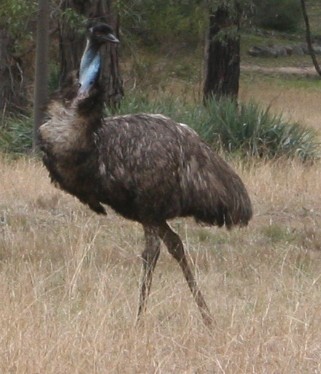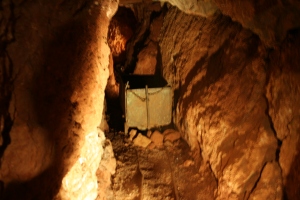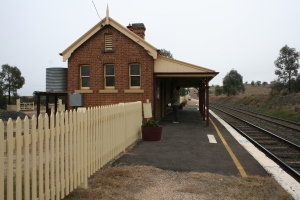Day 8 – Wednesday 13th July 2011: Wellington- – Stuart Town – Orange – Millthorpe
We started this morning with a reasonably early departure from the Wellington Motel, first driving around the tidy township. Wellington is located on the junction of two rivers, the Macquarie and the Bell. It is around 362 kilometres (225 mi) from Sydney, and has a population of around 4500.
I am conscious that this is the place that my cousin Phillip was sent to when he qualified as a teacher, being required to spend two years here as I recall. I can’t remember whether he said he loved his time here, but it seems as nice as any other well maintained country town. It has all the mandatory public buildings in good repair, its courthouse and police station and town hall and library. We tried to adapt a walking tour into a driving tour, with mixed success. As slow as Bill believed he was driving, we always seemed to whiz past the point of interest, and he was always overshooting the street we should have been in. Nonetheless, we worked it out well enough between us, so that we got a good idea of what the local historical society felt was of significance.
(I have since read a book set in this area called ‘The Mind of a Thief‘ by Patti Miller, who grew up on a farm outside Wellington. The book explores the history of the Wiradjuri Aboriginal people, contrasting their attachment to the land, and subsequent native title claim, with the conflict of colonisation).
The ‘city’ tour was really only filler in any case, as we made our way out of town and on towards the Wellington Caves. Visiting the caves was one of the major reasons we had made Wellington our destination, even though we didn’t know exactly what we would see once we were on site. The Wellington Caves are a group of limestone caves. There are several open to visitors, and cave diving is an option.
In the end, we decided on the Phosphate Mining and Fossil Tour as we figured we would see things that were not available at other sites. We arrived quite early for the 10am tour, so we passed the time strolling through the nearby Wellington Osawano Japanese gardens, bare and frost-bitten at this time of the year, but showing promise for when Spring comes, what with the twisted and bare branches of wisteria, and the skeletons of cherry blossom trees. A few ducks pretended to be frightened at our arrival, and they were the most active of life in these gardens.
Phosphate (used as fertiliser) was mined for a short four years in the early part of the twentieth century in the cave we toured. Some parts of the underground mine show the methods for shoring the tunnels and moving the phosphate. The most important feature of this cave, however, is the presence of fossils and bone fragments from ancient creatures. We encountered the giant wombat again, the Diprotodon, and there are also fossils of giant kangaroos and other forebears of Australian marsupials. The mine claims that even Charles Darwin became interested in the discovery of fossils in this cave, and that it influenced his thoughts on evolution. Believe that if you will.
A little further outside of Wellington is the Burrendong Botanic Garden and Arboretum. The jewel in this area of native plants and open spaces, is the Fern Gully. Established under protective shade cloth, visitors can stroll through a beautiful abundance of fern and rainforest flora, and enjoy the sound of the bird life that finds a haven here.
Moving on …… Not so far from Wellington is a small village called Stuart Town. It is farming and cattle country, and the few shops in the main street service the local population. The town came to prominence when the railway line was built in 1880, but if memory serves, the train now only stops once a day.
(Which reminds me of a friend who visited from England many years ago. For some reason he flew to Melbourne instead of Sydney. Arriving early morning, he got to the main railway station and asked for a ticket on the next train to Sydney. He was sold a ticket for the 6pm evening train. “No, I wanted the next train,” he said to the ticket seller. “Mate,” he replied, “That IS the next train.“)
We meandered around the small town and railway station, and then called in for lunch at a general store. It seemed to be the newsagent, bric-a-brac, opshop and cafe/takeaway, all rolled into one. I love these little finds. We not only had a tasty freshly prepared lunch, but also a good chat with the local lady who runs the place. There are always intriguing insights into what the area has to offer, and how they are getting on with their lives and the economy.
I came away with a few second-hand hard to get knitting patterns. (For a friend – long time since I did any serious knitting).
We were headed for Orange, another major central west town. Here we were in for our second shock on this tour – another town with heaps of accommodation – and all of it booked out! We were directed on down the highway to Millthorpe, which was not such a bad thing at all. It is a picturesque village that progress overlooked, so it is full of quaint architecture and boutique shops (many of which were closed). The tourist brochure says that at “965m above sea level, Millthorpe’s elevation ensures a distinct four seasons experience.” I’ll second that, this is what I wrote in my diary that night:
“>Have we come to the coldest place on earth? As we strolled around the village of Millthorpe in the late afternoon light, we came across a local man who looked as if he could be the last remaining wild man of Borneo. He chewed the fat with us about this and that, and told us of his mandatory trips to Sydney, and how he was always drawn back to this village, ever since he moved from Chatswood thirty years ago. He told us – according to his local knowledge – the maximum temperature for today was 5’ celsius; and how this crisp dry air meant that snow was on the way. We hope it doesn’t come in the next twenty-four hours, because if chains are necessary for the vehicle, we are in deep trouble. Of course, we don’t seriously think that we could need chains, but ice is a possibility, although not at the time we expect to be on the road. Now we are back in our motel room, and the air conditioning is making a difference to the icy chill in the room, we can’t imagine getting out of bed too early in the morning.
The tourist brochure goes on to say of winter in Millthorpe, “cold nights and open fires with frosty mornings and snowfalls.” Well, we did our best to lap up the experience, dining that night at a charming upmarket restaurant, with pre-dinner drinks in front of the open fire.
Tomorrow: The road back to the big smoke: Millthorpe – Bathurst – Lithgow – Sydney














Pingback: NSW Trainlink Outback Explorer from Sydney to Broken Hill | The Reluctant Retiree
I’m reading this (lying in bed) with more than a foot of snow on the ground outside. It’s funny how we think Aussie winters are so cold, even in places that get snow. I know it’s all relative as I spent my first couple of winters here thinking that surely I would literally freeze! I’m much “tougher” now 🙂
LikeLike
Yes, I hope the international readers realise that my references to cold are somewhat tongue in cheek. I spent four years in Europe without a winter coat. (doing the living on $10 a day experience). Whenever I was able to borrow someone else’s I felt I was living in the lap of luxury. Even camping in Scandinavia in the middle of summer was so cold that four of us Aussies would scrunch up together in a two person tent.
LikeLike
Beautiful gardens what a brilliant trip 😉
LikeLike
Thanks for stopping by. I know how busy you are! I have another trip to write up – and then we are off again on a fresh one next month.
LikeLike